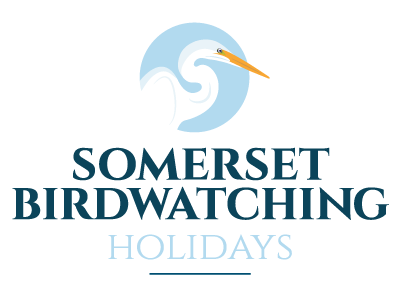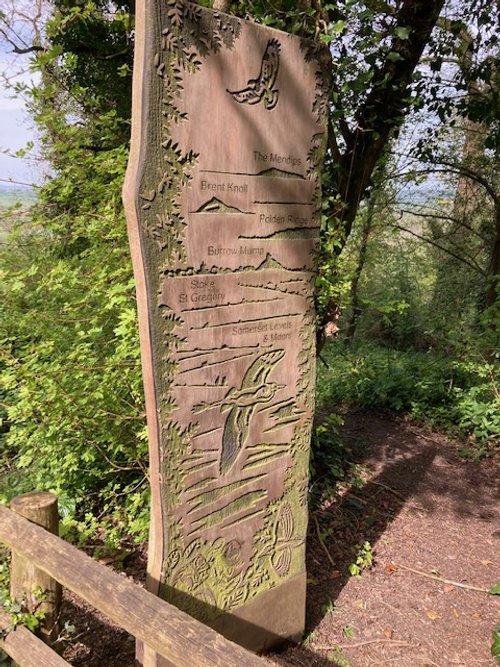Spring Birding 2nd-5th May 2023
SOMERSET BIRDWATCHING HOLIDAYS TRIP REPORT:
May 2nd-5th 2023
Tour Leaders: Stephen Moss & Graeme Mitchell
Tuesday 2nd May
A bright sunny afternoon showed the Somerset Levels off in all their glory. Dandelions and Rape Seed shone bright yellow against florescent green pastures.
Tealham Moor was busy with birdwatchers, so we continued to ‘Jack’s Drove’ where we enjoyed seeing our first Great White and Little Egrets along with good views of Meadow Pipits and Skylark.
We continued to Somerset Wildlife Trust’s showcase reserve at Westhay Moor where w had a gentle walk to the two new round thatched hides based on Iron Age dwellings that were found preserved in the peat near Glastonbury. A passing Marsh Harrier and fishing Great White Egret set the scene perfectly. We continued down the drove to a raised viewing platform where three Hobbies appeared like miniature fighter jets swooping and stooping after airborne insects.
A very squeaky Water Rail squatted nearby along with many Reed Warblers and Cetti’s Warblers, all hidden by their invisibility cloak amongst the thick reedbeds. Many butterflies were on the wing including Brimstone, Large White, Green-veined White and Orange Tip.
Returning home, we stopped again on Tealham Moor and quickly picked up two Yellow Wagtails – a male and a female – who were most obliging sitting out singing on a nearby bush. A Sedge Warbler and Reed Bunting shared the same bush as the male wagtail as two Egyptian Geese flew over.
In the evening we were joined by Stephen when we enjoyed one of Kay’s splendid suppers and we set out our plans for the next few days.
Wednesday 3rd May
For our first stop on this bright and rather breezy day we headed to Tealham Moor, where apart from a number of Skylarks singing things were fairly quiet; though we did also see a few Swallows heading north, three Swifts overhead, and a Whitethroat singing. En route to RSPB Ham Wall we saw a Sparrowhawk soaring over the east end of the moor, doing its classic ‘flap-flap-glide’ flight.
As always at this time of year, Ham Wall was ‘dripping with birds’ – we had hardly eft the car park before we had totted up several singing warblers: Chiffchaff and Blackcap in the car park, and Reed Warbler, Willow Warbler, Cetti’s and the usual Whitethroat (perched on the wire across the old railway line), as well as two baby Moorhens. More surprising was a calling Green Woodpecker – the first Stephen has ever recorded on the Avalon Marshes!
We walked slowly along the track towards the first Viewing Platform, stopped by two Hobbies chasing St Mark’s flies overhead, a daytime hooting Tawny Owl, a booming Bittern and a Great White Egret overhead; a drake Pochard and nesting Cormorants; brief views of a Cetti’s Warbler and Garden Warbler, and a Hobby perched in a distant tree.
The marshy area by VP1 held thirty Black-tailed Godwits en route to Iceland, about half showing their brick-red breeding plumage, and breeding Lapwings, as well as a Buzzard being attacked by a crow. And we waited for the Great Reed Warbler to appear we enjoyed close views of a noisy pair of Little Grebes, and heard a Reed Warbler singing above a chorus of Iberian Water Frogs – but sadly no sign of the rarity we hoped to see. On our way back we did enjoy excellent views of a drake Garganey with the flock of Gadwalls from VP1, and the second Sparrowhawk of the day; as well as, on Walton’s Marsh, a Great Crested Grebe with no fewer than four chicks – two on her back and two in the water.
After a coffee and biscuits in the car park (with a hovering Kestrel) we headed south across the Polden Hills to RSPB Greylake. Here we were greeted by singing Reed and a couple of Sedge Warblers – warbler no. 8 of the day! We also saw several Marsh Harriers, a pair of Whimbrels, and a pale-headed Red Kite – raptor no. 6 of the day! The view from the hide was fairly quiet, and with heat-haze, but we did see a pair of Teal, a Little Grebe, flocks of Greylag Geese and a handsome drake Wigeon (possibly injured) which had stayed on after the others had headed north to Iceland.
Following our usual excellent lunch at The King Alfred’s Inn, Burrowbridge (with Greenfinch singing in the car park, we had a brief cultural interlude at the Athelney memorial to King Alfred himself. This also produced some new birds: a good number of House Sparrows, two Stock Doves and a Lesser Black-backed Gull.
A stop at Stathe produced just a single Whitethroat, but at the railway bridge we managed distant views of two Cranes, singing Whitethroats and Sedge Warbler, and a single Raven (our only one of the day). Fortunately, the viewpoint at RSPB Swell Wood was much better, with views of a pair of Cranes in good light, flocks of Canada and Greylag Geese and Mute Swans, a male Marsh Harrier, Great White Egret and a distant Hobby, as well as a great view of the Somerset landscape stretching into the distance.
Swell Wood viewpoint
The wood itself had a lovely display of English bluebells and celandines, accompanied by a chorus of Chiffchaffs, Blackbirds and Coal Tits. We then went to our favourite hide for some ‘forest bathing’ – and a Grey Squirrel, Goldcrest, Coal, Blue and Great Tits, the nesting Grey Herons and Little Egrets, a Great Spotted Woodpecker, and best of all at least two (possibly three) Spotted Flycatchers – a rare sight in Somerset these days. The car park produced the expected Nuthatch, before we headed back to Walls Farm for dinner.
Thursday 4th May
Before our day out in the west of Somerset we headed to a secret location where we enjoyed excellent close-up views of nesting Grey Herons, Little Egrets and – most excitedly – Cattle Egrets, all nesting cheek-by-jowl, along with a colony of Rooks, in trees near a medieval churchyard. A walk around the church produced singing Chiffchaff, Blue Tit and Blackbird, and a pair of Blackcaps including a female showing well. We also saw Holly Blue and Speckled Wood butterflies, a Stock Dove, a Long-tailed Tit and singing Goldcrest.
We then crossed the River Parrett at Bridgwater (via the roof-nesting Herring and Lesser Black-backed Gulls) to Steart Marshes WWT Reserve. This new reserve is always very good, starting with two singing Sedge Warblers in the car park, followed by several singing Cetti’s and Reed Warblers, two Reed Buntings, and a Blackcap.
At the Quantock Hide we enjoyed excellent views of up to 100 Avocets (the most we have ever seen here during the breeding season), some of which had several very new youngsters, which follow their parents around to feed. There were also nesting Oystercatchers and Canada Geese, two pairs of nesting Little Ringed Plovers (very well disguised on the shingle), a Common Ringed Plover, and lots of Shelducks, as well as a courting pair of Great Black-backed Gulls.
The Mendip Hide was as ever fairly quiet, apart from a nice male Marsh Harrier quartering the expanse of mud and vegetation; so we returned to the car park and enjoyed coffee and biscuits before heading farther west, via the wonderful medieval church at Stogursey (a Somerset corruption of Stoke Courcy) – complete with the carvings of spoonbills on the end of one pew! En route we saw House Martins in one village, followed by a passing Red Kite – our second of the trip.
After an excellent lunch at the Plough in Holford village, we headed up Hodder’s Combe just as the rain began to start. Fortunately it soon stopped, and we enjoyed fabulous views of a female Lesser Spotted Woodpecker, calling and feeding right above our heads – only the second time we have ever seen this elusive little woodpecker on our trips. The Combe seemed fairly quiet, but as ever it gradually unfolded its birds: Coal Tit, Goldcrest, calling Green Woodpecker, singing Chiffchaffs and Song Thrush, Grey Wagtail on the stream, several male Pied Flycatchers in the beech woods (near their nestboxes), a singing (but sadly unseen- Redstart, brief views of a Jay, Buzzard above, a Nuthatch calling, and on the way back wonderful views of a Dipper which Graeme had seen on the way up. Sadly, and worryingly, no Wood Warblers at all.
Friday 5th May
‘Plan B’ was called for when we left Walls Farm, due to very dark skies and heavy rain – so we headed for Catcott Lows reserve near the village of Burtle, where a comfortable hide adjacent to the car park was a welcome prospect.
Fortunately, when we arrived the sun had come out and so had the birds, with Sedge Warbler, Blackcap, Wren, and Reed Bunting all in full song around the car park and an elegant Great White Egret stalked the wet margins beyond. From the hide we saw and assortment of ducks including Gadwall, 2 male Wigeon, Shoveler, Tufted and Teal, with honking Canada and Greylag Geese. At least 3 pairs of nesting Lapwing were protecting their chicks from prowling gulls and in the distance a Cuckoo called.
Now that the day was much brighter, we made for the River Parrett estuary and Stephen and Graeme’s Patch where on most Saturday mornings you will find us watching birds whilst discussing the latest Netflix series and the weekend’s football.
From the Sloway Bridge spanning the Huntspill River there were Cetti’s and Reed Warblers along with a rather wheezy Greenfinch, and just as we expected all other birds to be scared off by two approaching wild-swimmers Graeme noticed the unmistakable shape of an obliging male Kingfisher sitting out on top of some tall reeds – after it had disappeared, the female shot out from below a flowering blackthorn bush, perhaps indicating a nest burrow in the vicinity.
Down by the estuary at the Sluice a Grey Heron fished beside two Little Egrets in the muddy water. The tide was receding, however there was still plenty to see, namely a good number of whistling Whimbrel, a single and obviously larger Curlew along with a passing small flock of Dunlin.
whimbrel
In the dense wooded copse and hedges were singing Lesser Whitethroat with its idiosyncratic ‘rattle’ sound, Bullfinch and a beautiful Holly Blue Butterfly. We bumped into Mike Dilger leading another birdwatching group, who was cock-a-hoop to tell us of the Short-eared Owl they had just seen and several Wheatear that were showing well along the seawall – we saw the Wheatears, but sadly dipped-out on the owl, such is birdwatching!
To finish our 4-day trip we celebrated our many sightings with a coffee out of the back of the van listening to another Lesser Whitethroat, a low-flying Green Woodpecker, and another Red Kite – or possibly the same one as we had seen the day before at Steart. The total list for the trip as a whole – including birds we heard – topped the 100 mark at 103 species!



